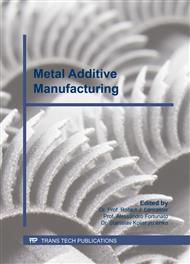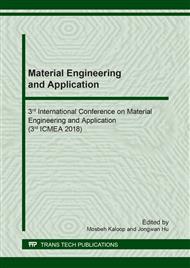[1]
D. Banerjee, J. C. Williams, Perspectives on titanium science and technology, Acta. Mater. 61 (2013) 844–879.
Google Scholar
[2]
M. Li, X. Liu, A. Xiong, Prediction of the mechanical properties of forged TC11 titanium alloy by ANN. J. Mater. Proc. Tech. 121 (2002) 1–4.
DOI: 10.1016/s0924-0136(01)01006-8
Google Scholar
[3]
M. Peters, J. Kumpfert, C. H. Ward, C. Leyens, Titanium alloys for aerospace applications, Adv. Eng. Mater. 5 (2003) 419-427.
DOI: 10.1002/adem.200310095
Google Scholar
[4]
H. Wang. Progress on Rapid Solidification Laser Processing for Advanced Materials and Components. World Sci-tech R & D, 26(3) (2004) 27-31.
Google Scholar
[5]
X. Cheng, J. W. Fisher, H. J. Prask et al. Residual stress modification by post-weld treatment and its beneficial effect on fatigue strength of welded structures. International Journal of Fatigue, 25(9) (2003) 1259-1269.
DOI: 10.1016/j.ijfatigue.2003.08.020
Google Scholar
[6]
A. G. Olabi, M. S. J. Hashmi, The effect of post-weld heat-treatment on mechanical-properties and residual-stresses mapping in welded structural steel. J. Mater. Process. Technol. 55(2) (1995) 117-122.
DOI: 10.1016/0924-0136(95)01794-1
Google Scholar
[7]
Y. Zhu, D. Liu, X. Tian, et al, Characterization of microstructure and mechanical properties of laser melting deposited Ti–6. 5Al–3. 5Mo–1. 5Zr–0. 3Si titanium alloy, Mater. Des. 56(7) (2014) 445-453.
DOI: 10.1016/j.matdes.2013.11.044
Google Scholar
[8]
Y. Zhu, J. Li, X. Tian, et al, Microstructure and mechanical properties of hybrid fabricated Ti–6. 5Al–3. 5Mo–1. 5Zr–0. 3Si titanium alloy by laser additive manufacturing, Mater. Sci. Eng. A, 607(12) (2014) 427-434.
DOI: 10.1016/j.msea.2014.04.019
Google Scholar
[9]
Y. Zhu, X. Tian, J. Li, et al, The anisotropy of laser melting deposition additive manufacturing Ti–6. 5Al–3. 5Mo–1. 5Zr–0. 3Si titanium alloy, Mater. Des. 67 (2015) 538-542.
DOI: 10.1016/j.matdes.2014.11.001
Google Scholar
[10]
Y. Zhu, X. Tian, J. Li, et al, Microstructure evolution and layer bands of laser melting de- position Ti–6. 5Al–3. 5Mo–1. 5Zr–0. 3Si titanium alloy, J. Alloy. Comp. 616(2) (2014) 468-474.
DOI: 10.1016/j.jallcom.2014.07.161
Google Scholar
[11]
E. Brandl, A. Schoberth, C. Leyens, Morphology, microstructure, and hardness of titan- ium(Ti-6A1-4V) blocks deposited by wire-feed additive layer manufacturing(ALM). Mater. Sci. Eng. A. 532 (2012) 295-307.
DOI: 10.1016/j.msea.2011.10.095
Google Scholar
[12]
S. W. Williams, F. Martina, A. C. Addison et al. Wire + Arc Additive Manufacturing. Mater. Sci. Technol. 32(7) (2016) 641-647.
Google Scholar
[13]
O. H. Petersen, D. Burdakov, A. V. Tepikin. Process control and development in wire and arc additive manufacturing. Cranfield University, 30(3) (2012) 218-226.
Google Scholar
[14]
F. Wang, S. Williams, M. Rush. Morphology investigation on direct current pulsed gas tungsten arc welded additive layer manufactured Ti6Al4V alloy, Int. J. Adv. Manuf. Tech. 57(5-8) (2011) 597-603.
DOI: 10.1007/s00170-011-3299-1
Google Scholar
[15]
M. J. Bermingham, L. Nicastro, D. Kent, et al, Optimising the mechanical properties of Ti- 6Al-4V components produced by wire + arc additive manufacturing with post-process heat treatments. J. Alloy. Comp. 753 (2018) 247-255.
DOI: 10.1016/j.jallcom.2018.04.158
Google Scholar
[16]
J. D. C. Teixeira, B. Appolaire, E. Aeby-Gautier, et al, Transformation kinetics and microstructures of Ti17 titanium alloy during continuous cooling, Mater. Sci. Eng. A, 448(1) (2007) 135-145.
DOI: 10.1016/j.msea.2006.10.024
Google Scholar
[17]
F. Campbell, Phase Diagrams: Under- standing the Basics, ASM Int. Mater. Park, Ohio, 2012 (2012) 346–349.
Google Scholar
[18]
B. Y. Huang, C. G. Li, L. K. Shi, G. Z. Qiu, T. Y. Zuo, Chinese Material Engineering Dictionary, Chemical Industry Press, Beijing, 2005 (2005) 607-614.
Google Scholar
[19]
J. H. Wang, C. Q. Xia, Y. Q. Chen, et al, Effect of heat treatment on microstructure and properties of TC11 titanium alloy, Heat Treat. Met. 35(1) (2010) 81-85.
Google Scholar
[20]
C. M. Liu, H. M. Wang, X. J. Tian, et al, Subtransus triplex heat treatment of laser melting deposited Ti–5Al–5Mo–5V–1Cr–1Fe near β titanium alloy, Mater. Sci. Eng. A, 590 (2014) 30-36.
DOI: 10.1016/j.msea.2013.10.002
Google Scholar
[21]
X. P. Cui, G. Lin, Y. B. Song et al. Effect of hot plastic deformation and heat treatment on microstructure and properties of TC11 titanium alloy. Trans. Mater. Heat Treatment, 30(2) (2009) 89-92.
Google Scholar
[22]
R. G. Deng, G. J. Yang, X. N. Mao et al. Effects of Forging Process and Following Heat Treatment on Microstructure and Mechanical Properties of TC11 Titanium Alloy. Mater. Mech. Eng. 35(11) (2011) 58-57.
Google Scholar



